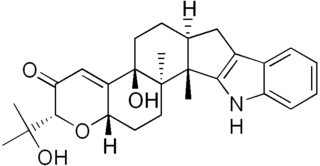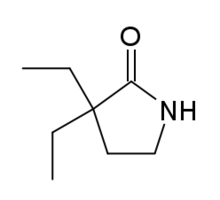Anticonvulsants are a diverse group of pharmacological agents used in the treatment of epileptic seizures. Anticonvulsants are also increasingly being used in the treatment of bipolar disorder and borderline personality disorder, since many seem to act as mood stabilizers, and for the treatment of neuropathic pain. Anticonvulsants suppress the excessive rapid firing of neurons during seizures. Anticonvulsants also prevent the spread of the seizure within the brain.

Topiramate, sold under the brand name Topamax among others, is a medication used to treat epilepsy and prevent migraines. It has also been used in alcohol dependence and essential tremor. For epilepsy this includes treatment for generalized or focal seizures. It is taken orally.

Androsterone, or 3α-hydroxy-5α-androstan-17-one, is an endogenous steroid hormone, neurosteroid, and putative pheromone. It is a weak androgen with a potency that is approximately 1/7 that of testosterone. Androsterone is a metabolite of testosterone and dihydrotestosterone (DHT). In addition, it can be converted back into DHT via 3α-hydroxysteroid dehydrogenase and 17β-hydroxysteroid dehydrogenase, bypassing conventional intermediates such as androstanedione and testosterone, and as such, can be considered to be a metabolic intermediate in its own right.

Clonazepam, sold under the brand names Klonopin and Rivotril, is a medication used to prevent and treat anxiety disorders, seizures, bipolar mania, agitation associated with psychosis, OCD and akathisia. It is a tranquilizer of the benzodiazepine class. It possesses anxiolytic, anticonvulsant, sedative, hypnotic, and skeletal muscle relaxant properties. It is typically taken by mouth but is also used intravenously. Effects begin within one hour and last between six and twelve hours.

Primidone, sold under various brand names, is a barbiturate medication that is used to treat partial and generalized seizures and essential tremors. It is taken by mouth.

Neurosteroids, also known as neuroactive steroids, are endogenous or exogenous steroids that rapidly alter neuronal excitability through interaction with ligand-gated ion channels and other cell surface receptors. The term neurosteroid was coined by the French physiologist Étienne-Émile Baulieu and refers to steroids synthesized in the brain. The term, neuroactive steroid refers to steroids that can be synthesized in the brain, or are synthesized by an endocrine gland, that then reach the brain through the bloodstream and have effects on brain function. The term neuroactive steroids was first coined in 1992 by Steven Paul and Robert Purdy. In addition to their actions on neuronal membrane receptors, some of these steroids may also exert effects on gene expression via nuclear steroid hormone receptors. Neurosteroids have a wide range of potential clinical applications from sedation to treatment of epilepsy and traumatic brain injury. Ganaxolone, a synthetic analog of the endogenous neurosteroid allopregnanolone, is under investigation for the treatment of epilepsy.

Pheneturide, also known as phenylethylacetylurea, is an anticonvulsant of the ureide class. Conceptually, it can be formed in the body as a metabolic degradation product from phenobarbital. It is considered to be obsolete and is now seldom used. It is marketed in Europe, including in Poland, Spain and the United Kingdom. Pheneturide has a similar profile of anticonvulsant activity and toxicity relative to phenacemide. As such, it is only used in cases of severe epilepsy when other, less-toxic drugs have failed. Pheneturide inhibits the metabolism and thus increases the levels of other anticonvulsants, such as phenytoin.

Etiocholanolone, also known as 5β-androsterone, as well as 3α-hydroxy-5β-androstan-17-one or etiocholan-3α-ol-17-one, is an etiocholane (5β-androstane) steroid as well as an endogenous 17-ketosteroid that is produced from the metabolism of testosterone. It causes fever, immunostimulation, and leukocytosis, and is used to evaluate adrenal cortex function, bone marrow performance, and in neoplastic disease to stimulate the immune system. Etiocholanolone is also known to be an inhibitory androstane neurosteroid, acting as a positive allosteric modulator of the GABAA receptor, and possesses anticonvulsant effects. The unnatural enantiomer of etiocholanolone is more potent as a positive allosteric modulator of GABAA receptors and as an anticonvulsant than the natural form.
The galanin receptor is a G protein-coupled receptor, or metabotropic receptor which binds galanin.

Allopregnanolone is a naturally occurring neurosteroid which is made in the body from the hormone progesterone. As a medication, allopregnanolone is referred to as brexanolone, sold under the brand name Zulresso, and used to treat postpartum depression. It is given by injection into a vein.

Kv7.2 (KvLQT2) is a voltage- and lipid-gated potassium channel protein coded for by the gene KCNQ2.

Kv7.3 (KvLQT3) is a potassium channel protein coded for by the gene KCNQ3.

Potassium voltage-gated channel, shaker-related subfamily, member 5, also known as KCNA5 or Kv1.5, is a protein that in humans is encoded by the KCNA5 gene.

IDRA-21 is a positive allosteric modulator of the AMPA receptor and a benzothiadiazine derivative. It is a chiral molecule, with (+)-IDRA-21 being the active form.

Paxilline is a toxic, tremorgenic diterpene indole polycyclic alkaloid molecule produced by Penicillium paxilli which was first characterized in 1975. Paxilline is one of a class of tremorigenic mycotoxins, is a potassium channel blocker, and is potentially genotoxic.
A potassium channel opener is a type of drug which facilitates ion transmission through potassium channels.

17-Phenylandrostenol (17-PA), or (3α,5α)-17-phenylandrost-16-en-3-ol, is a steroid drug which binds to GABAA receptors. It acts as an antagonist against the sedative effects of neuroactive steroids, but has little effect when administered by itself, and does not block the effects of benzodiazepines or barbiturates.

Galnon is a drug which acts as a selective, non-peptide agonist at the galanin receptors GALR. It has anticonvulsant, anxiolytic, anorectic and amnestic effects in animal studies.

5β-Dihydrotestosterone (5β-DHT), also known as 5β-androstan-17β-ol-3-one or as etiocholan-17β-ol-3-one, is an etiocholane (5β-androstane) steroid as well as an inactive metabolite of testosterone formed by 5β-reductase in the liver and bone marrow and an intermediate in the formation of 3α,5β-androstanediol and 3β,5β-androstanediol and, from them, respectively, etiocholanolone and epietiocholanolone. Unlike its isomer 5α-dihydrotestosterone, 5β-DHT either does not bind to or binds only very weakly to the androgen receptor. 5β-DHT is notable among metabolites of testosterone in that, due to the fusion of the A and B rings in the cis orientation, it has an extremely angular molecular shape, and this could be related to its lack of androgenic activity. 5β-DHT, unlike 5α-DHT, is also inactive in terms of neurosteroid activity, although its metabolite, etiocholanolone, does possess such activity.

Estradiol 17β-benzoate (E2-17B) is an estrogen and an estrogen ester—specifically, the C17β benzoate ester of estradiol—which was never marketed. It is the C17β positional isomer of the better-known and clinically used estradiol ester estradiol benzoate. Estradiol 17β-benzoate was first described in the 1930s.

















